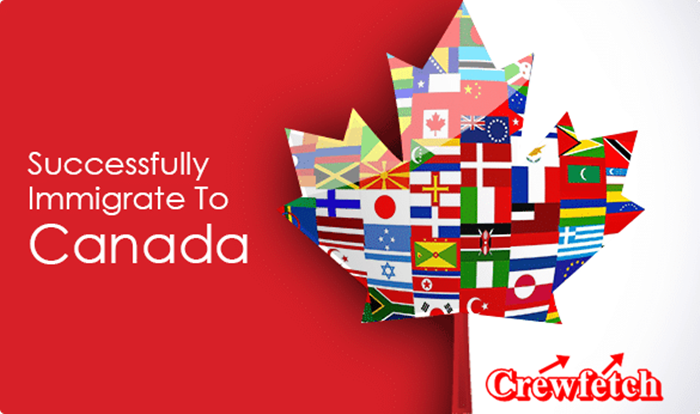If you’re interested in moving to Canada, but don’t have any work experience in the country. You may be wondering whether or not this is even possible. After all, without some kind of career history in Canada, how will you convince immigration officials that you’ll be able to support yourself when you move there? Well, good news — there are actually several different ways to immigrate to Canada without work experience. Continue reading, we’ve summarized everything you need to know on the ways to move to Canada without work experience.

There are hundreds of visa and immigration programs in Canada. And many of them don’t require applicants to have any work experience to be eligible to stay in Canada. Moreover, many of these programs open up opportunities for foreign workers to become permanent residents in Canada, as long as they meet the requirements.
3 Ways to Move to Canada Without Work Experience
However, there are three primary programs that generally give foreigners the best chance to live, study and work when they move to Canada without work experience. They are as follows:
Family Sponsorship
If you don’t plan to come to Canada to study and work in Canada, there is still a fantastic program. The Canada Family Sponsorship program allows foreigners with a family member, guardian, spouse, etc to move to Canada without work experience. If you have family in Canada, you can apply for immigration under a special program designed for family reunification. In fact, under some circumstances, you can come to Canada as a temporary foreign worker before your sponsorship is approved. All you need is a Canadian relative who can vouch for your character and will help support you financially while you get settled in Canada.
However, to qualify, your sponsor must be either: A parent (including step-parents) or grandparent; Your spouse or common-law partner; A child (including adopted children); Your brother or sister; Or another individual related by blood or marriage who has been living with you for at least 12 months immediately prior to applying.
Moreover, this person is called your sponsor and must meet certain requirements set out by Citizenship and Immigration Canada (CIC). You may also need to prove that you’re legally married or are in a common-law relationship with your sponsor. For more information on how to obtain a family visa sponsorship, see How to Sponsor Family Members for Permanent Residence.
How to Apply for Canadian Family Visa Sponsorship
Here are the steps set out by the Government of Canada for the Canadian family visa sponsorship application.
- To begin with, you will need to get your application kit. You can get this from the Canadian government’s website. It will include your checklist, instructions for going about the process, and necessary application forms.
- Then, the next step will be to gather your documents. At this point, you will use the government’s checklist to make sure you and your sponsor to make sure you have all the necessary documentation to apply to the program.
- Furthermore, you should then download and fill out every application form on the Canadian government’s website and re-upload them to the Canadian immigration portal.
- After that, you pay the necessary processing fees
- Then, cross-check your application before submitting it to avoid common mistakes. Make sure every form, document, and fee is covered. Any errors can slow down or stop the processing of your application.
- Finally, submit your forms and documents to the Canadian government portal and wait for your application to be processed.
The Working Holiday Visa Program
This is the best pathway for you if you are looking to come to Canada for work or travel. The Canada Working Holiday Visa via the International Experience Canada (IEC). is for young foreigners traveling through Canada. It’s primarily for those looking for contract or seasonal work in Canada, such as ski instructors, fruit pickers, or summer camp guides.
This visa allows you to work and travel in Canada for up to one year. Applicants must be between 18 and 30 years old, hold a valid passport from their home country, have at least CAD$1,000 in savings (you can also use your personal funds), and have good health insurance. The program has yearly quotas of available visas; when they’re full, you have to wait until January 1st of next year. If you don’t meet all of these requirements, but still want to move to Canada, there are other ways to do so. But it will take more time and effort on your part. For example, you could apply for a permanent residency through one of many programs that allow foreign workers into Canada with no or limited work experience.
However, there are some restrictions or requirements for these visas, though. The Working Holiday Visa is a temporary open-work permit. It allows you to work for any company in Canada for your work permit. It also allows you to move around Canada and move from job to job throughout Canada. Provided you can fund yourself. Moreover, a Working Holiday Visa is only available to 35 countries worldwide. Therefore, if you are from one of the following countries, then you can apply for a Canada Working Holiday Visa.
The Post Graduate Work Permit Program (PGWPP)
If you’re looking for a way to move to Canada with work experience, another option is applying for a Post Graduate Work Permit. The Post Graduate Work Permit Program (PGWPP) provides recent graduates of Designated Learning Institutions (DLIs) in Canada with a work permit. This can be applied for after completing an undergraduate degree and will let you stay in Canada for up to 3 years after your studies are complete. It allows them to stay and work in Canada until they’ve built up sufficient work experience to either extend their work permit or progress to permanent residence.
Meanwhile, a Canadian DLI is a post-secondary educational institution designated by a government or provincial authority to enroll international students. Moreover, a great perk of the program is that it allows international students (who have had at least 4 years of post-secondary education) or Canadian Permanent Residents or citizens who’ve finished their studies abroad (after having lived in Canada for at least 1 year) take on internships of up to 2 years that can lead directly into jobs in their field.
This means that if you want to study in Canada but also want to gain valuable work experience before returning home, there are options available! To find out more about moving to Canada from another country, check out our ultimate guide to moving here.
Requirements for the PGWP
Furthermore, just like any other immigration program, there are requirements to be fulfilled in order to be considered eligible for a Post Graduate Work Permit (PGWP). They are as follows:
To begin with, you must have completed your academic, professional, or vocational training at a DLI in Canada;
- Have studied full-time;
- Have a transcript and official letter from your DLI proving you’ve completed the requirements to obtain your qualification;
- Have studied in Canada in a program of at least 8 months and no longer than 3 years.
Meanwhile, applicants for a Post Graduate Work Permit must apply within 180 days of receiving written confirmation that they’ve completed their studies from their DLI, such as an official transcript. Then, they should apply for the PGWP on the Government of Canada’s website as soon as they have their guarantee.
Nonetheless, we mentioned above that PGWPP holders can either extend their work permit or progress to permanent residence. Well, to further elaborate, once you get your PGWP, you can live and work in Canada long enough to qualify for the Canada Experience Class (CEC). This is one of the streams of Canada’s Express Entry immigration program. However, the CEC requires you to live in Canada for at least 12 months to gain permanent residence.
Final Thoughts on How to Move to Canada Without Work Experience
Moving to another country can be daunting, but it’s worth doing if you love it there. If you want a job in Canada, make sure you know how different your options are from your home country. Do some research into other parts of their economy and culture so that you aren’t surprised by any differences; otherwise, you might miss out on what makes living there so great.
Now, you know the three ways to move to Canada without work experience. But there are still plenty more pathways t immigrate to Canada, with or without work experience. Visit the Canadian government’s official immigration website to explore and find which immigration and visa programs are perfect for you.



